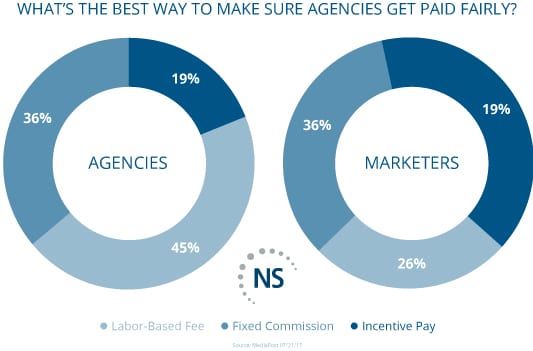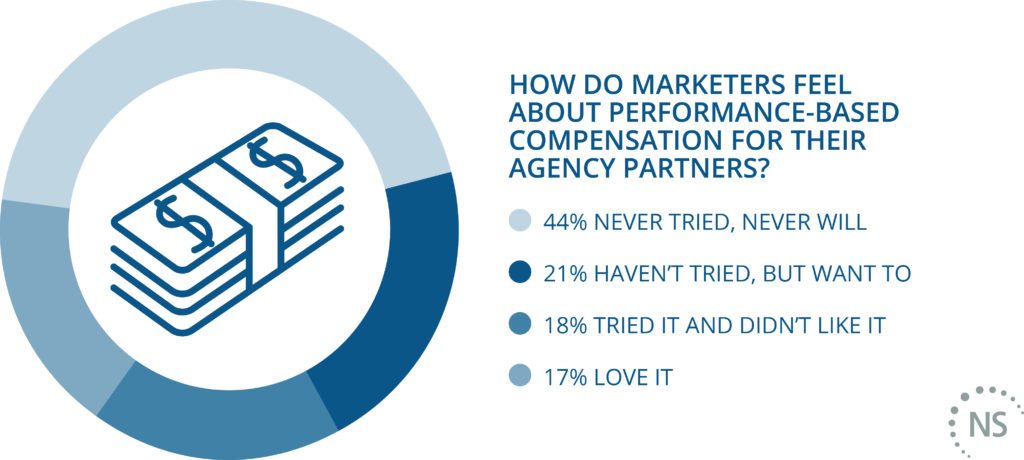MediaPost recently published an article on agency compensation that presents the findings of a survey conducted by the Association of National Advertisers (ANA) on how agencies want to be paid and how marketers think they should pay agencies.

The results showed that while labor-based fees were more preferential to agencies (45%), marketers would rather pay using incentive-based methods (40%). By contrast, only 19% of the agencies who partook in the survey concurred with this opinion. We happen to fall in that 19%, but the results of this survey are of no surprise to us.
Early this year, we conducted a Twitter poll asking client and agency marketers whether they would consider a pay-by-results compensation model.
 44% of the 405 voters said they never have and never will try this method of payment. While we can’t identify every participant (it is a Twitter poll after all), our research shows, like the ANA’s, agencies reject this payment model more than marketers.
44% of the 405 voters said they never have and never will try this method of payment. While we can’t identify every participant (it is a Twitter poll after all), our research shows, like the ANA’s, agencies reject this payment model more than marketers.
At Nelson Schmidt, we are long time proponents of incentive-based compensation. We explore the topic in one of our first blog posts from 2015 and even include performance-based accountability as one of our three brand pillars. We recognize that marketers desire pay-by-results as an indication that there is a commitment by the agencies to deliver a return on their clients’ marketing investment in their work.
While we understand that incentive-based compensation would be of great benefit to marketers and is clearly their preferred method of payment, why is it that agencies are slow to get on board?
Nelson Schmidt’s Chief Operating Officer, Cody Pearce, believes there are three factors contributing to agencies’ dilatory shift to performance-based compensation. The first, and most obvious concern is in defining the right metrics. “Determining the appropriate KPIs and performance metrics by which compensation can be determined is often not black and white,” said Cody Pearce. “Revenue is the ultimate measure but agencies may be only indirectly responsible for contributing to top line growth. Pricing strategies, product or service quality and channel performance can dramatically impact revenue and often fall outside the agency’s influence.” It is imperative that the agencies explicate how their operations contribute to driving client’s business growth, which might not be the easiest task. Typical marketing communications metrics like brand awareness and perception are good indicators but clients may feel that they are only leading indicators and too soft to attach compensation. Every client has unique drivers for growth. Once the agency justifies how it contributes to these drivers, then they can implement hard metrics to quantify the impact and value it can create.
The second and third reasons Cody believes agencies are slow to get behind performance-based compensation are shared risk and accountability. Marketers and agencies need to share the risk of such an arrangement. Many agencies, including Nelson Schmidt, promote the idea of shared risk and are willing to implement a performance based compensation model. The key word being “shared.” In many instances, clients are willing to pay less if agency contribution falls short of performance goals, but what is often ignored is the opportunity for agencies to earn more based on outperforming goals. For performance-based compensation to work, it must be a two-way street. Both parties must be willing to share the risk – and reward – for agencies to get on board.
But, for there to be shared risk/reward, there has to be measured accountability. “Let’s face it, if otherwise not required, most marketers, client and agency alike, would settle for measuring performance based on output and how the work is perceived versus what real outcomes it delivers.” However, we know that in order to prove agency outputs as successful in delivering outcomes, there must be an element of measurement. Analytics are oftentimes spread out within a marketers’ company structure (as we’ve previously examined) and they are often missing the enterprise data that is necessary to capture the desired results.
Vice President of Media Services, Scott Penniston adds, “there’s often a lack of correlation between cause and action that drives the performance metric, such as ‘why did someone visit a website?’ For performance-based compensation to work, marketers need to determine what the influencing factors that drive consumer action are, and how you can correlate that with the actions provided by the agency’s work.” To provide that element of accountability, marketers need to invest in research, planning and the measurement infrastructure to track and report true outcomes and therefore performance-based payments.
While both Cody and Scott addressed certain concerns agencies have over pay-by-results and solutions to those issues, the bigger picture shows that agencies and client-side marketers need to come to a better agreement on the best method of payment. My question to marketers is, how do you get paid? We’ll sign up for that. Let’s structure our agreements around the same measurements you have in your role. The biggest concern agencies have with performance-based compensation is that results don’t necessarily reflect the strength of the campaign. There are many factors that go into results and, therefore, revenue. Just as marketers don’t get paid based entirely on revenue, agencies shouldn’t either, but we can use similar metrics to come up with a fair compensation system. The main component should be outcome-driven versus by the outputs we create.
There are many ways to successfully implement pay-by-results compensation. Top line growth and revenue can be a basis of performance-based compensation, but it should be one of several components. The survey shows that marketers are more than willing to give performance-based compensation a try. Agencies, it’s time we get on board.
Originally Published 2017






